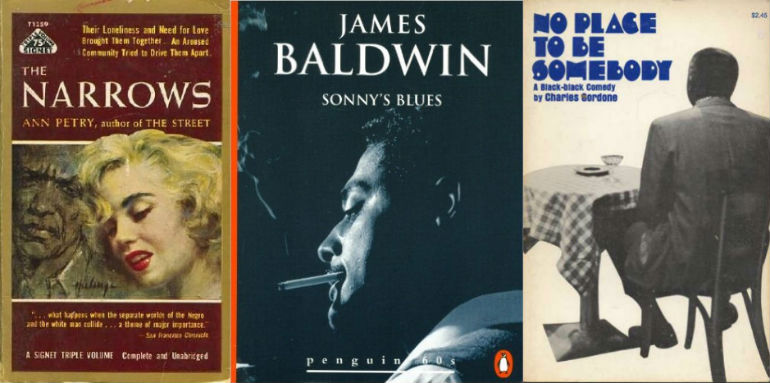African American Literature During the Civil Rights Era
by Olympia Scott, AALBC Intern Spring 2019

The Civil Rights era was the culmination of the two and a half centuries of struggle for basic human rights for African American. African American literature during the Civil Rights era would come to embody the artistic, political, spiritual, and mental renewal of Black people that would push the movement toward progress by creating a generation of historically and socially aware Black people.
During the later Civil Rights era (abt 1954 – 1968), African American literature would power movements with both peaceful and militaristic approaches to achieving human rights, as well as inspire some of the most classic and sacred works of Black literature in the genre. This writing not only encompassed the scholarly view of the sociopolitical environment of the time, but also works of fiction, poetry, and memoir that imaginatively hone in on the experiences of Black people.
The Narrows is a fictional tale written in 1953 by Ann Petry. The story unfolds as Link, a brilliant young African American man, who is currently working as a bartender for lack of better opportunity — although he is a graduate from Dartmouth College. One night he saves a white woman from an attack, and afterward they drink together. He discovers in their conversation that her name is Carmilo. They become romantically acquainted, in violation of the rigid social codes that barred their relationship with possibly deadly consequences. He does not know however, that she has given him a fake name because she is actually married, wealthy, and only escaped to his side of town to escape the monotony of her secure, white washed life. The story was written at a time when Black Americans were routinely, and violently, terrorized and marginalized with Jim Crow laws and institutionalized racism, especially in the Southern regions of the country. Petry’s torrid and heart breaking novel shed light on the treacherous way that racism and social injustice impedes on the personal and social lives of people. Controversially, the topic of interracial relationships, still a relevant topic in Black social life today, forced readers to face their own inner truths and socialized mentality when it comes to matters of miscegenation at a time when the nation was submerged in racial turmoil. It symbolizes African American literature’s ability to have its unique story told through the lens of a Black character who is living a life that is not different than many African Americans of the time.
The prolific writer James Baldwin is an essential voice in African American literature in the Civil Rights era and in the narrative of Black struggle. His 1957 popular masterpiece, Sonny’s Blues is a short story which begins with the unnamed narrator coming to understand that his estranged younger brother, who has had a history of delinquent and addictive behavior, will be going back to prison. Sonny is a musician, possessing great talent and an all around passive demeanor. The narrator turned out much differently than his troubled brother, as he is a high school math teacher with a stable family life. Once Sonny is finally released, he comes to live with the narrator and his family in their childhood neighborhood of Harlem, causing a strained situation. Tension leads to an inevitable argument between the two where Sonny reveals the motives for his drug use. The story explores such themes as addiction, incarceration, music, and family in the Black community. Although not overtly about racial tension, this piece of Civil Rights era African American literature tells a poignant tale surrounding themes that runs deeply and adversely in the everyday lives of many Black Americans.
Charles Gordone 1969 play entitled No Place to be Somebody: A Black-Black Comedy, received the 1970 Pulitzer Prize for Drama. Gordone was the first African American playwright to receive the Pulitzer Prize, and this production was the first off-Broadway play to receive this honor, making this play a historic landmark in African American Civil Rights era literature, as well as all Black literature. The story centers around patrons of Johnny’s Bar owned by the young Johnny Williams, where he bartender tries to outwit a syndicate of white mobsters. Parallel plots focus on the patrons, who each fulfill an active an important role in the multifaceted and humorous play, and target themes such as race, ethnicity and gender throughout the play. The Civil Rights movement was at a fever pitch at this time, with movements becoming more militaristic, and less peaceable, and Gordone’s brash play interacts with the themes of these movements among others to bring them to life on stage.
African American literature during the Civil Rights era elevated the craft of Black writing to a complex level of self expression that could only be actualized through the captivating struggle that was the Civil Rights era. New, revolutionary approaches to understanding and expressing Blackness in America was fertile ground to create the literature of this time. The rebellious undertone and the effort to assert one’s Blackness and humanity could be felt through much of the literature which was published during the era.
African American Literature Begins with the Slave Narrative
African American Literature During the Harlem Renaissance
African American History Books on AALBC
Last Updated: Wednesday, April 24, 2019
